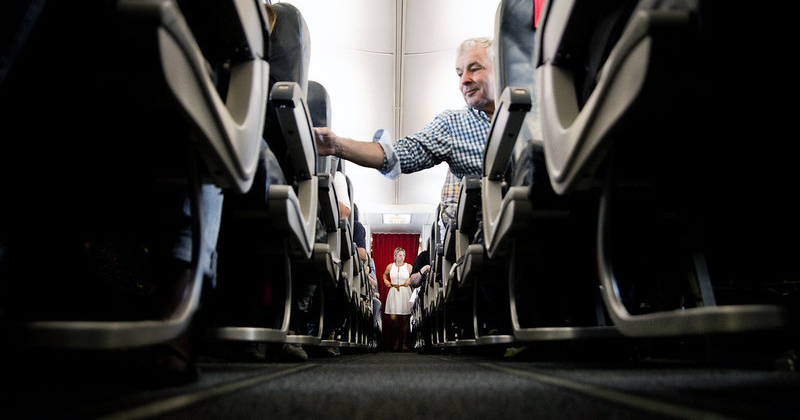Intervention proposal

“All the information contained in this section is for guidance only. Psious environments are supporting tools that must be used by the healthcare professional within an evaluation and intervention process designed according to the characteristics and needs of the user.
Also remember that you have the General Clinical Guide in which you have more information on how to adapt psychological intervention techniques (exposure, systematic desensitization, cognitive restructuring, chip economy…) to Psious environments.”
Example of intervention Fear of flying
A proposal for a treatment protocol that includes the Psious tool is described below. It is recommended to combine virtual reality with traditional techniques, such as relaxation or cognitive restructuring.
SESSION 1: PSYCHOEDUCATION
- Information about flying phobia is provided (origin, upkeep and appearance of the triple system cognitive, physiological and motor).
- Information about the functioning and safety of planes.
- Treatment techniques that will be used throughout the protocolare explained (emphasizing the exposure to the Virtual Reality environments).
HOMEWORK
Hand out of the Psychoeducation file (see appendix).
SESSION 2- 3: RELAXATION
- The patient learns and practices two types of relaxation techniques: controlled breathing and Jacobson’s progressive muscular relaxation.
- Familiarization with the Psious platform. The patient learns to use the VR helmets and navigate inside the virtual scenes.
HOMEWORK
Daily practice of relaxation techniques. The self-registers of relaxation and negative thoughts are completed (see appendix)
SESSION 4: COGNITIVE RESTRUCTURING
- Revision and adjustment of the patients negative thoughts.
- Cognitive restructuring for each of the negative thoughts. Two kinds of cognitive therapy may be used: the one proposed by Beck or the one belonging to Ellis.
HOMEWORK
Daily practice of relaxation techniques. The self-registers of relaxation and negative thoughts are completed (see appendix)
SESSION 5: VR EXPOSURE + TRADITIONAL TECHNIQUES
As of the fifth session of treatment the gradual and systematic exposure to the virtual environments begins. Throughout all exposure sessions, VR is combined with techniques of relaxation and cognitive restructuring.
- The patient is exposed to:
- Patients house on a sunny day (the news is on TV).
- Taxi ride on a sunny day (the news is on the radio).
- Boarding gate on a sunny day.
HOMEWORK
Daily practice of the relaxation techniques and tasks of self-exposure to stimulus related to planes.
SESSION 6: VR EXPOSURE + TRADITIONAL TECHNIQUES
- Homework review.
- The patient is exposed to:
- Taxi ride on a sunny day
- Boarding gate on a sunny day. The display with the flight schedule is shown, also the window with planes taking off and landing.
- Plane take-off on a sunny day.
HOMEWORK
Daily practice of relaxation techniques and tasks of self-exposure to stimulus related to planes.
SESSION 7: VR EXPOSURE + TRADITIONAL TECHNIQUES
- Homework review.
- The patient is exposed to:
- Boarding gate on a sunny day and with comments from other passengers. The screen with the flight schedule and the window with planes taking off and landing are observed.
- Plane take-off on a sunny day.
- Flight situation. Elements of internal sense exposure are introduced.
HOMEWORK
Daily practice of relaxation techniques and self-exposure tasks to stimuli related to planes.
SESSION 8: VR EXPOSURE + TRADITIONAL TECHNIQUES
- Homework review.
- The patient is exposed to:
- Plane take-off on a sunny day. Turn on comments.
- Flight situation and short turbulence. Internal sense exposure.
- Landing.
HOMEWORK
Daily practice of relaxation techniques and self-exposure tasks to stimulus related to planes.
SESSION 9 VR EXPOSURE + TRADITIONAL TECHNIQUES
- As of the ninth session of treatment the exposure is re-started to the virtual environments but with a higher level of difficulty. Like in the rest of the exposure it is used in combination with relaxation and cognitive restructuring.
- The patient is exposed to:
- At home on a rainy day (the news is on TV).
- Taxi ride on a rainy day (the news is on the radio).
- Boarding gate on a rainy day.
HOMEWORK
Daily practice of relaxation techniques and self-exposure tasks to stimulus related to planes.
SESSION 10 VR EXPOSURE + TRADITIONAL TECHNIQUES
- The patient is exposed to:
- Taxi ride on a rainy day with the radio on. Elements of internal sense exposure are introduced.
- Boarding gate on a rainy day. The screen with the flight schedule and window with planes landing and taking off is observed.
- Plane take-off on a rainy day.
HOMEWORK
Daily practice of relaxation techniques and self-exposure tasks related to planes.
SESSION 11 VR EXPOSURE + TRADITIONAL TECHNIQUES
- Homework revision.
- The patient is exposed to:
- Boarding gate on a rainy day. Elements of internal sense exposure are introduced.
- Plane take-off on a rainy day. Elements of internal sense exposure are introduced.
- Flight situation on a rainy day with comments. Elements of internal sens exposure are introduced.
HOMEWORK
Daily practice of relaxation techniques and self-exposure tasks to stimulus related to planes.
SESSION 12 VR EXPOSURE + TRADITIONAL TECHNIQUES
- Homework review
- The patient is exposed to:
- Plane take-off on a rainy day. Turbulence appears.
- Flight situation on a rainy day with turbulence. Elements of internal sense exposure plus comments
- Landing on a rainy day with turbulence.
HOMEWORK
Daily practice of relaxation techniques and tasks of self-exposure to flight-related stimuli.
SESSION 13: VR EXPOSURE + TRADITIONAL TECHNIQUES
- The therapeutic process is evaluated and future self-exposure tasks are programmed, as well as booster sessions.
- Relapse management and prevention.